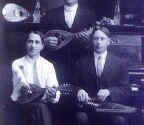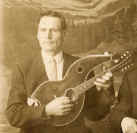![]() Bert
Amend & the One-Armed
Musicians
Bert
Amend & the One-Armed
Musicians ![]()
Updated March, 2011
by Gregg Miner, as part of

|
|
||
|
Updated March, 2011 |
by Gregg Miner, as part of |
 |
| Without any doubt,
these are the most fascinating Knutsen instrument
photographs ever discovered! Even more fascinating is the story behind
it, and we have the grandson himself, Robin Amend, to tell it. His
own article about his grandfather appears at the
bottom.
The man on the right in all four images is Bert Amend, who, as a shake mill
worker, lost an arm at the turn of the twentieth century. Determined not
to give up music, he ultimately invented several attachments and
devices to enable himself and similarly handicapped players to play many
different instruments (he was granted a patent for a chord-fingering
device for the piano). During the early 'teens his trio was billed as
"The Greatest Novelty Musical Act in Vaudeville." What has so far been missing from both Robin's story, and the period articles he quotes, is the unique nature of the guitars! While one appears to be some type of unusual six-string (presumably non-Knutsen), there are two very fancy Knutsen 18-course harp guitars discernible in these photographs, with a third 11-course in the possession of Robin. The two known Knutsen harp guitars are both mid-Seattle-era "Lower Bass Point" models, and are clearly smaller scale instruments (somewhere around 3/4 size). One is right-handed, one is left-handed. Notice that Bert (and his main partner) can either fret or pluck either instrument with their single hand! Robin says that the instrument in his possession has no treble string bank (therefore is not one of these), is "small" also, and has either label SE1 (early Seattle) or SE2 (mid-Seattle). The left-handed instrument in the first photo also appears to have label SE1 (possibly SE2) barely resolvable when magnified. The glare and angle of the face when the photo was taken disguises the black color - this instrument (Inv #HGS43) is the same one that appears in the second and third photos. The pointed lower bout can only be seen on the table in the last photo at far left. Note that after the first photo was taken, the group has omitted every other bass string, leaving three (they also added an extra screw "nut-post" on the bass arm, which tells us the photo chronology). In the images below, The third photo shows the first two instruments side-by-side in scale, suggesting that their scale lengths and other dimensions may be slightly different. I was delighted to notice that the second floating "bridge" rests for the trebles appear to be the same curved, thin bone pieces that were found on the "zither harp guitar" (HGS40)! Photos ca. 1913-1915 |
||||
| The missing part of the story is: Why Knutsens? Why harp guitars at all, and especially Knutsen's 18-course version with the doubled third string and super-trebles? One might expect that standard six-string guitars would have been difficult enough to learn the "two-player" techniques on, but clearly these gentlemen were more than up to the challenge! Not only does Bert "switch hit" on each side of the guitar, but he does so while bowing the cello with his special bow attachment! | Here are the two harp guitars taken from the first photo - as they are in scale, they seem to show variations in scale length and proportions. | |||
|
These instruments have the look of a custom set made specially by Knutsen for this group - all are small, with possibly
custom scale lengths, all have very fancy trim and inlay, and they are a
right- and left-handed pair - presumably to accommodate the specific needs of the
player combinations. Interesting also is that both have the doubled G-string,
seen only twice on previous Knutsens. Could it be that Amend desired
this double-G for some specific reason and Knutsen obliged? Interesting
how these compare with the similarly fancy, left-handed, small-scale,
double-G-string HGS25. |
||||
 |
 |
| Close-up of Amend shows three standard bowlback mandolins. | I had my suspicions, and when I received the original postcard, I confirmed it - this harp mandolin survived and is in the Archives! See #HM19. |
|
(left images from eBay - I was unable to obtain the original postcard. Two images at right copyright Gregg Miner) |
|
| 4//12/2005 UPDATE: When Robin Amend
originally shared his priceless photos and information with me, he
also mentioned a surviving harp guitar of his grandfather's that was not
one of those pictured - making a total of three Knutsen
harp guitars (and possibly the harp mandolin above) owned by Amend and
his group.
We finally have an image of it. See HGS51. |
 (image copyright Amend Music Center, courtesy Brian Alboucq) |
This article was printed in Nostalgia Magazine in November of 2000 and gives a little insight into why
the Amends have a music store and why they think music is so important for all people.
Robin and Debbie Amend own AMEND MUSIC CENTER at 1305 W. 14th Ave. in Spokane. Their neighborhood music store offers music lessons, instrument repair and sales. They repair band instruments for all of Spokanes school districts. |
|
If you enjoyed this article, or found it useful for research, please consider supporting Harpguitars.net so that this information will be available for others like you and to future generations. Thanks!
|
[Biographical]
[Instruments]
[Historical
Photos]
[Credits]
[FAQ]
[Bibliography]
[Updates]
[Links]
[Contact]
[Home
(Knutsen Archives)] [Home
(Harpguitars.net)]
All Site Contents Copyright © Gregg Miner, 2002, 2003, 2004, 2005,2006,2007,2008,2009. All Rights Reserved.
Copyright and Fair Use of material and use of images: See Copyright and Fair Use policy.